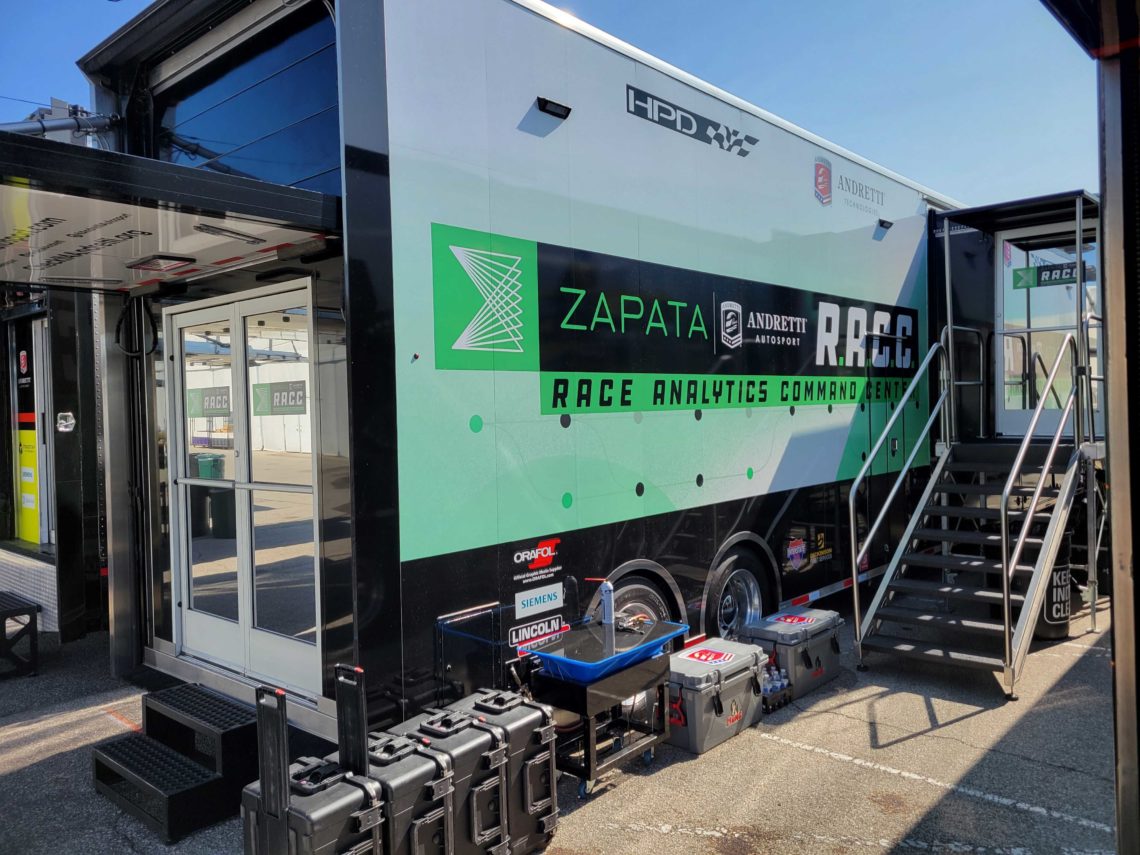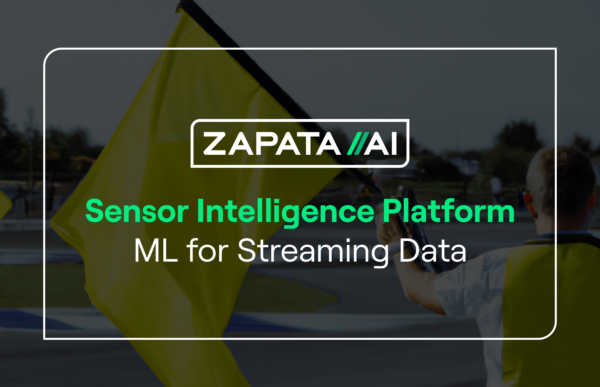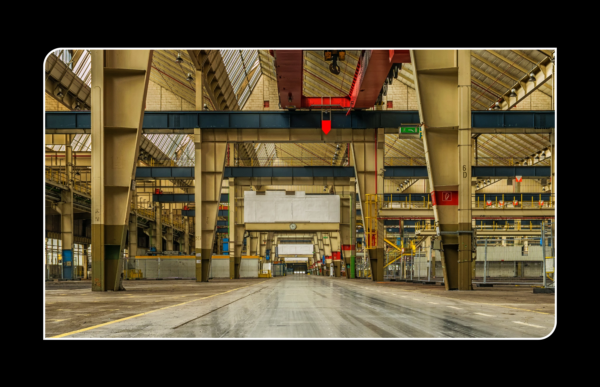Within the next decade, we expect the first fault-tolerant quantum computers to become available. These computers will have a transformative impact, solving problems that were previously impossible to solve with classical computers. But just because these fault-tolerant devices will be available does not mean they will be instantly useful. Companies will not be able to simply install a quantum computer (or, more likely, access cloud-hosted quantum services) and reap a benefit overnight.
To explain why, I’ll use an analogy from the history of trucking (in honor of our new truck-based Race Analytics Command Center – aka “The R.A.C.C.” — the nerve center for our partnership with Andretti Autosport).
The Zapata Race Analytics Command Center (R.A.C.C.) is a mobile engineering environment where Zapata and Andretti engineers work side-by-side to apply accelerated analytics, powered by Orquestra, to seek a real-time performance advantage at NTT INDYCAR SERIES events.
Now, trucking may seem unrelated to quantum computing. But consider that supply chain optimization is one of the most hotly anticipated use cases for quantum computing. In fact, our First Annual Report on Enterprise Quantum Computing Adoption, released in January, found that 63% of respondents in the transportation industry are in the early stages of quantum adoption — the highest proportion of any sector. And in many ways, the experience of early truckers parallels the experience of early adopters of quantum computing.
The Early Days of Trucking (and Quantum Computing)
In 1896, German inventor Gottlieb Daimler created the world’s first truck. It was essentially a horse-drawn carriage with a two-cylinder engine instead of horses. But for companies involved in shipping at the time, this primitive motorized truck promised several advantages over the horse-drawn carriage. Gasoline would soon be cheaper than hay and oats, and the engine’s increased “horsepower” promised faster travel and could support heavier loads. Trucks would also end shippers’ reliance on centralized train depots in urban areas and enable more flexible routing.
But in the first ten years of the truck’s existence, they were little more than a technological novelty, appreciated more for their advertising appeal than for their utility as a transport vehicle. This is roughly where we are today with quantum. Although quantum computers promise to one day deliver an advantage for a wide range of use cases, enterprises today may tout a proof-of-concept or other nominal quantum investment as a PR tactic — without yet gaining any practical business advantage.
The Trucks Won’t Drive Themselves
By 1899, trucks were available on the market from companies like the Daimler Manufacturing Company and the Winton Motor Carriage Company. But to have a truck at this time, you needed specialized expertise in maintaining and operating a truck that very few people had. The same is true today with quantum. Any quantum software you can buy in the near future will require a highly skilled and specialized workforce: people that can maintain the software, monitor its performance, manage data and experimental records, track drifts in the models, and make tweaks as necessary.
Unfortunately, the pool of skilled quantum scientists and engineers is vanishingly small. Of the 69% of enterprises we surveyed that have started on the path to quantum adoption, 51% are already building their quantum teams. If you wait until the age of quantum supremacy to hire quantum staff, all the best talent will be long gone.
You will also want to foster relationships with external consultants. The executives we surveyed agreed: 96% said they could not successfully adopt quantum computing without external help. Outside consultants can save you time and energy by helping to identify use cases, anticipate hurdles, and build the software infrastructure you will need to effectively leverage quantum computing.
Without Roads, There Can be No Trucks
Drivers aside, the biggest barrier to early truck adoption was the absence of roads and gas stations. You could buy a truck, but you needed this infrastructure in place to make it useful. To extend the analogy, you could hypothetically install a working quantum computer or execute a quantum-powered software application, but you won’t get a practical advantage unless you have the software infrastructure in place to integrate that device with your existing tools.
To add value, quantum hardware and software components will need to be integrated with the rest of the enterprise IT stack: HPC clusters, ETL processes, databases, S3 buckets, security policies, etc. This is important: even the most advanced quantum algorithm won’t deliver a speedup if it’s slowed down by a fragmented and disjointed workflow. This calls for a unified platform, like Orquestra®, that can abstract the complexities of running hybrid quantum-classical workflows into automated, containerized tasks.
Having a unified quantum workflow (as we recently covered here) also allows users to benchmark, optimize, and execute across a wide range of computing options. Quantum is just one category of new computing technologies, and within that category lie several distinct types of computers, including superconducting, trapped ion, photonic, and quantum annealing devices. Each of these computing types could end up the champion of solving certain problem types, and a flexible workflow platform allows users to test out different options without starting over.
Perhaps the most valuable advantage of workflows, however, is their compatibility with future advances in quantum hardware and software. The last thing you want is to invest millions into developing a quantum application, only to have a new device or software component render your work obsolete. Although fault-tolerant quantum devices are still on the horizon, enterprises can start now by translating their high value problems into quantum solvable mathematics and building their quantum-enabled workflows well in advance. Once more powerful fault-tolerant devices come online, they can be swapped in on the backend while leaving the workflow intact.
Where Are We Headed?
In 1912, a five-man crew from the Charles W. Young Company of Philadelphia completed America’s first transcontinental truck delivery. With almost no maintained roads, gas stations or rest stops, the crew arrived in San Francisco in 91 days. Today, a truck can complete the same journey in under 48 hours, thanks to advances in truck design and the infrastructure of the Interstate Highway System.
Early examples of quantum supremacy experiments are a bit like that 91 day journey—impractical but exciting milestones nonetheless. Parallel advances in quantum technology will one day enable speedups similar to or surpassing what we’ve seen in the history of trucking. The question is, are you prepared to build the highways?
Remember, as roads improved and gas stations proliferated, trucking grew quickly: by 1914 there were already 100,000 trucks in America. Six years later, there were 1 million trucks. Quantum is poised for similar growth: we’re now in what IBM has termed the Quantum Decade. But to reach quantum’s full potential, we need to overcome the same infrastructure and workforce challenges that held back the age of the truck.
Learn more about building quantum-classical workflows with Orquestra.







